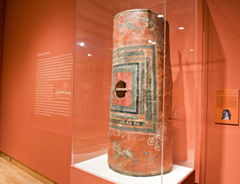Published: April 2011
In 1920, British soldiers bivouacking on a bluff alongside the Euphrates River in what is now eastern Syria unearthed a wall decorated with frescoes. Subsequent excavators from Yale University and the French Académie des Inscriptions et Belle-Lettres revealed it to be part of Dura-Europos, a long-lost, multicultural city established by Macedonians in about 300 B.C. The settlement was seized by Parthian soldiers (from northern Iran) in the late second century B.C., then by the Romans in 165 A.D. It became a major garrison and trading post—148 acres at its peak—only to be abandoned after a successful siege by Sasanians (from southern Iran) in 256. For some 1,500 years the city lay largely preserved by a blanket of stone and sand.
Finds at the site include the earliest surviving Christian house church, the first extant synagogue, pagan temples, and more than 12,000 artifacts, including 60 percent of surviving Roman military archives. Of this trove, 75 items—frescoes, sculptures, and articles of daily life from Yale’s Dura-Europos collection—are on display for the first time in some 30 years, at the McMullen Museum through June 5, 2011. The exhibition is co-curated by Lisa Brody of the Yale Art Gallery and Gail Hoffman, a classics professor at Boston College.







